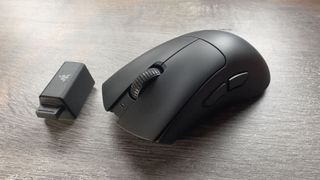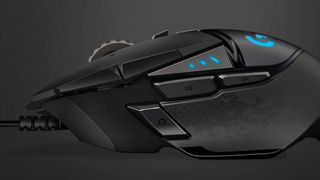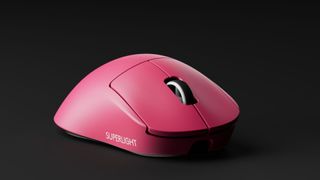If you’re looking for advice on your first gaming mouse purchase, you’ve come to the right place. While there are so many gaming mice options available on the market, it can be easy to look at something cheap and cheerful and wonder why you might want to spend a bit more on something that looks very similar—or what advantages you can actually gain from buying a gaming mouse over a standard squeaker.
I’ve been using gaming mice since they had little rubber balls in the bottom, and enjoyed a misspent youth cleaning the gunk out of the rollers to try and gain an advantage on my next Counter Strike match. Those days are long gone, of course, but now I get my hands on some of the best gaming mice available, and as a result I’ve put together this guide to help you decide on the best gaming mouse for you.
We’re going to discuss five things I wish I could have told Young Andy™ to look out for in his early gaming mouse purchasing days, in the hope they’ll be of use to you today. Of course, the first thing I would have told him is “gaming mice are awesome in 2024 if you pick the right one”, but luckily you’re here right now, so let’s skip that and get on to the good stuff!
Oh, one more thing before you get scrolling: Black Friday 2024 is fast approaching, and we take great pleasure in finding the best Black Friday deals on gaming mice. We hunt for the best bargains all year round, but now’s an excellent time to pick up a good gaming mouse for less.
- Wired or wireless isn’t as big a deal as you think
- Don’t fall for the esports hype
- Shape makes the difference
- Cheap can absolutely be cheerful
- Weight is important, but it depends how you game

Andy Edser
Andy’s always digging around the PC Gamer kit cupboard to find the latest gaming mice, and to be honest we can’t stop him. That’s because he’s always looking for the next mouse to review, in the hopes that one day he finds gaming mouse nirvana. That, plus his years of rodent-handling experience, makes him the perfect pick to guide you on which mice to buy, and which to avoid.
1. Wired or wireless

Wired or wireless isn’t as big a deal as you think
One of the first choices you’re going to have to make in your next gaming mouse purchase is whether to go for a wired model, or a wireless. There are good arguments to be made for both, but personally I don’t think it matters as much as some people think.
Let’s go over the pros and cons for a second. The best wireless mice are, let’s face it, a bit cooler and more modern feeling, simply by virtue of the fact that attaching your peripherals by a cable feels slightly old-school. Plus, it means you can move them all over your desk without rearranging your cable management, and they can feel a little freer to move, seeing as you’re not dragging the wire around with you.
On the cons side, they tend to be more expensive, you have to charge them, and some will say that they can feel the lag and latency introduced by even a very fast wireless connection.
Put simply, I think that last point is dubious. Plenty of highly-ranked gamers use wireless mice, and anything made by a reputable brand is likely to have imperceptible latency to anyone with anything less than superhero-esque reflexes.
Ultimately, I’d pick a wireless mouse over a wired model simply for the added convenience. But I regularly shift over to wired models in my day-to-day usage, and while it might take a second to get used to the cable moving with my hand, after mere moments I’ve forgotten about it.
It’s mostly personal preference here, so don’t worry if your budget won’t stretch to wireless—or if you can’t be bothered to plug in your mouse semi-regularly for charging. Either will work just fine for gaming, so feel free to pick and choose based on other factors instead.
2. Sensor speeds and ratings

Don’t fall for the esports hype
You’ll notice that many gaming mice will market themselves as “competitive”, or “built for esports”, with huge DPI numbers, 8K sensors and the like. Now, let me be clear here—if you’re looking to start a serious multiplayer career, or really do want to min/max your potential to rise to the top of the leaderboards, these things can make a difference.
But let’s be honest, it’s the fleshy thing holding the mouse that really makes the difference here, and that’s you. No-one became a pro gamer because they had the right mouse, while others faltered because theirs was technically slower. These things matter for esports professionals, but for the rest of us? It’s the same mentality as sneaker companies trying to sell you Cristiano Ronaldo’s football boots to make you a pro soccer player.
Are they nice boots? Probably. Will they make a huge difference to your performance? Doubtful. So don’t fall into the trap of thinking that you need the biggest numbers on the box to get the best mouse for you. While these mice do deliver the performance they advertise, where you’ll actually notice the difference day-to-day is in shape, feel, and quality. These things are difficult to quantify, whereas big numbers are easy to shove in to the marketing copy.
That’s why you should trust subjective reviews from proper human beings who’ve had the chance to get their hands on these mice themselves. Luckily, you’re on a site that’s chock full of them. So while big numbers are a nice thing to have, don’t feel like you have to spend a ton to get the very best. There are far more important things to consider than that.
3. Shape is king

Shape matters when it comes to day-to-day comfort
Here’s something I’ve noticed isn’t discussed enough when it comes to buying a gaming mouse: Shape matters, and it might take a few attempts to find the mouse that’s right for you. That’s because everyone’s got differently-sized hands, and so what’s a perfect fit for me with my long skinny fingers might not be right for you—especially if you’ve got the sort of mitts that can crush an orange with a single squeeze.
Luckily, mouse manufacturers are well aware of this, so there’s a plethora of options available, from sizeable rodents with serious heft to tiny, ultralight affairs that are better suited to more delicate hands with a lighter touch.
One thing to pay attention to is how you find yourself gripping your mouse while you game. Some people rest their entire palm on a mouse as they move, and for those I’d highly recommend something on the substantial side, like the Razer Basilisk V3 Pro.
Others have a more “claw-like” grip, delicately resting their fingers on the mouse while their palm floats above. This being the case, it’d be better to go for something smaller (and lighter) to better respond to those fine motor movements, like the Razer Deathadder V3 Hyperspeed, or the TurtleBeach Burst II Air.
Of course, most mice can still be used both ways, so it’s not a massive thing to worry about. And when it comes to shape, you’ll be relying on pictures and reviews to judge whether a mouse will fit your hands correctly when you pull it from the box.
But as a general rule, if you’re a palm user I would suggest something with a very raised back, whereas if you’re a finger-gripper I’d go for something shallower, smaller, closer to the desk, and potentially slightly flared on the edges of the buttons.
4. Price

Cheap can absolutely be cheerful
So, you’ve probably looked at a few mice on this page and found that some are fairly reasonably priced, whereas others are quite expensive. If you’re on a very tight budget, have no fear—you can absolutely get a great gaming mouse for less than the price of takeout for one, if you shop carefully, of course.
For a start, if it’s got a non-sensical brand name that you’ve never heard of before, I’d avoid. That’s not to say that there aren’t decent gaming mice out there from relatively little-known manufacturers, but the results will vary. And I’m here to get you the best bang for your buck, so let me clue you into a well-known fact: The Logitech G203 Lightsync can often be found for less than $30, and it’s a corker of a gaming mouse.
So, it’s not a wireless model. Big deal. If you’re prepared to put up with a cable (and let’s be honest, it’s not exactly a hassle) then your cheap gaming mouse options become legion. The Logitech G502 Hero is another great shout for a cabled-yet-brilliant rodent, as we often see it drop down to the $40-$50 mark, and it’s even got adjustable weights.
But what if you’ve got your heart set on a wireless mouse, but you’re still pinching the pennies? Well, Logitech to the rescue again, as you’ll want to take a look at the Logitech G305 Lightspeed, another fabulous mouse that can often be found well under $50.
It’s not just Logitech that make great cheap gaming mice of course, but they do make some of our favorites. And we test them up, down, sideways and back to front for good measure, and can confirm that they keep trucking long after you’d expect a cheap mouse to have given up—and they feel great for gaming, too.
5. The great weight debate: The choice is yours

Weight is important, but it depends how you game
So, you’ll probably have noticed in your mouse shopping adventures that gaming mice often advertise their weight, or rather the lack of it, quite heavily. This is because many gamers prefer an ultralight mouse for very quick, flick-of-the-wrist movements, and it’s another number you can stick on the box that manufacturers hope will draw customers towards the “best” mouse for them.
The truth is? Weight is a very subjective thing. So by all means, go for a light mouse if you really like the idea of a super snappy, hyper-responsive gaming peripheral that skids around your desk at the lightest touch.
Personally, I usually use the rather large and heavy Logitech MX Master 3S for productivity stuff, and switch to a lighter model for gaming. However, that’s not always the case. It simply depends on what sort of game I’m playing. So for shooters, action games, and things that require an ultra snappy response, I’ll go light for sure. While we’re on that subject, Logitech happen to do one of our favourites, the Pro X Superlight, natch.
But for a bit of Civ VI, or a slow-paced RPG? Its much bigger, heavier brother does just fine.
More than that, manufacturers compete with each other—down to the single gram—so they can say they have “the lightest gaming mouse”, and it’s a bit of a race to the bottom that’ll probably end with us all having to tape our mice to the desk when not in usage, lest they float towards the ceiling. It’s all a bit silly if you ask me, so while weight is definitely a factor to look out for, really your choices are: “A bit heavy”, “A medium weight” and “So light it’s almost like it’s not there”.
Again, don’t fall for the hype. If you like light, buy light, but don’t bother prioritising one mouse over the other simply because it’s a couple of grams lighter than a competing model. Check it against the other factors I’ve listed in this guide instead, and you won’t go far wrong in finding the right mouse for you.
